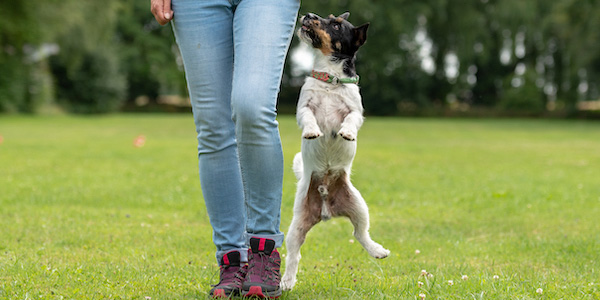 While puppies jumping up for attention might seem cute, it's much less adorable when they're a full-grown 100 lb. dog leaping at your face.
While puppies jumping up for attention might seem cute, it's much less adorable when they're a full-grown 100 lb. dog leaping at your face.
Not only can their nails scratch you up, but large dogs can knock you over in their excitement.
And it's not just large dogs — small and medium dogs can just as easily knock over children or elderly adults.
Toy breeds that jump on people might not be big enough to knock you over, but they can easily become a tripping hazard!
Beyond being a possibly dangerous behavior, it can be quite an intimidating experience to have a dog jumping on you. While the dog might be super excited and just want to say hi, a flying ball of fur, claws, and teeth can be quite scary for people not familiar with or comfortable around dogs.
Teach Your Dog Not to Jump on People
How to React When Your Dog Jumps
Why Do Dogs Jump on People?
Connect with a Certified Dog Trainer
Fortunately, stopping your puppy or dog from jumping on people is easier than you might think — it just takes consistency on our part and setting your dog up for success! While it's always easier to start teaching a young puppy not to jump in the first place, it's never too late to teach a dog not to jump.
Let's look at how you can teach your dog to stop jumping on you or other people and the reasons why dogs jump on people.
How to Train Your Dog Not to Jump
1. Manage the Environment
2. Train Alternative Behaviors
3. Practice Polite Greetings with People
4. Capture the Wanted Behavior
Teaching your puppy or adult dog not to jump comes down to the following:
-
Preventing jumping from happening in the first place
-
Teaching your dog what TO do instead of jumping
-
Using effective consequences when your dog does jump
(Hint: these aren't the types of punishments you might think of off the top of your head! Pushing, kneeing, or yelling at a dog rarely works to teach a dog to stop jumping in the long run, and has unintended consequences.
We'll cover what "negative punishment" means further below, and how to use it when teaching your dog not to jump.)
Set Your Dog Up For Success: Managing the Environment
Set up the environment to your advantage. Every time your dog is successful in jumping on you, the more it becomes a habit.
If your dog isn't able to jump on you in the first place, there isn't the chance their jumping might accidentally be rewarded by you.
Have Rewards Readily Available
Think about where your dog tends to jump on people the most. Is it the front door when you arrive home? Is it in the kitchen when you're preparing meals? Is it when you're on a leashed walk and they want to greet someone? Wherever or whenever their jumping occurs, be prepared to take advantage of the training opportunity!
Have something you can use to reward your dog with when they get it right. Most often, training treats are the highest value reward for most dogs.
Keep stashes of treats where you need them. If your dog loves a certain toy, make sure it's easily accessible to grab and reward with a game of tug or fetch.
Plan for preemptive and proactive training! Here are a few ways to make sure you've got easy access to training rewards:
- Keep treats in your car so you can grab a few before you go inside to greet your dog.
 Hang a jar of treats on the wall (high enough that your dog can't reach it) by doorways. There are lots of great ideas for wall-mounted treat jars that you can find online or DIY.
Hang a jar of treats on the wall (high enough that your dog can't reach it) by doorways. There are lots of great ideas for wall-mounted treat jars that you can find online or DIY.- Have a dog "cookie" jar on your kitchen counter.
- Keep a fun dog toy in the garage so you can grab it before you walk inside.
- Always wear a treat pouch, like this one I use from Petsafe, when on walks with your dog.
- Remember that your attention can be a real-life dog training reward! Looking at, touching, or talking to your dog, even sternly, is rewarding to them — so make sure you're using these to reward your dog for behaviors you like. And on the flip side, make sure you aren't rewarding your dog with these things when they are jumping.
Use Gates or Ex-Pens to Block Off Space
Set up a baby gate, a sturdy free-standing gate, or an exercise pen to block off areas where jumping happens the most (such as the front door or other entryways). Not only is this useful in preventing your dog from pouncing on you when you walk through the door, but it's also an ideal setup for training practice.
Gates blocking doorways are also essential if your dog tries to door dash. I used a free-standing gate with a built-in door for my entryway, which you can see below:
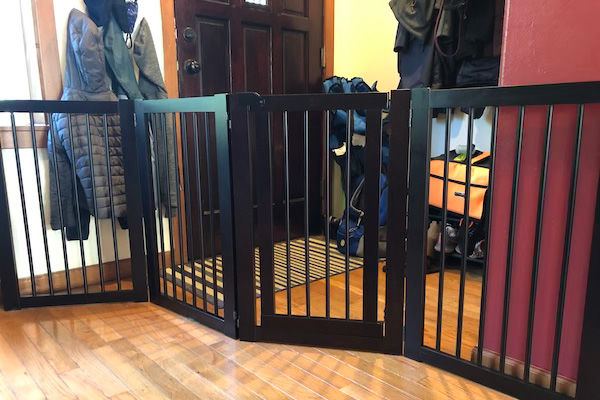
Keep Your Dog On Leash
Whether your dog is jumping on passers-by while on a walk or on visiting guests, keeping them on a leash, with the leash in your hand, gives you much more control over the situation.
You can prevent a successful jump on someone by simply guiding your dog further away. This also makes it easier to help your dog learn polite greetings, and "earning" interaction with people, which you'll learn about in the next section.
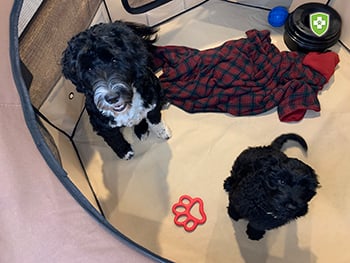 Use Your Puppy's Playpen or Your Dog's Safe Space
Use Your Puppy's Playpen or Your Dog's Safe Space
Sometimes there's just too much going on in your home to deal with your dog's jumping habit. You might be making a holiday dinner or just trying to relax with visitors.
Never feel bad using a safe, dog-proofed confinement area for your puppy or dog to prevent unwanted behavior like jumping.
However, you don't want to confine your dog if doing so will cause anxiety or other unwanted behaviors — keep them on a leash if this is the case with your dog.
Make sure your puppy has learned that their puppy zone is an awesome place to hang out by themselves for a few minutes. Set up your dog's safe space as a comfortable and positive place to be for your adult dog.
If your dog loves their crate, you can certainly use it as a place for them to hang out for a while until they've calmed down and are less likely to jump out of excitement. When the doorbell rings, take your puppy to their playpen or your dog to their safe space and give them an interactive stuffed treat toy to enjoy while you greet your guests.
Managing your dog's environment is the most important step to stop their jumping up. Without preventing jumping from happening in the first place, it will be harder and take longer to teach your dog what to do instead of jumping – especially if they like to jump up on guests who don't know your training plan.
Reward an Incompatible and Desired Behavior
Okay, now that we've covered ways you can manage the environment to prevent jumping and be ready to train, let's get down to the nitty-gritty!
What Do You Want Your Dog to Do INSTEAD of Jumping Up on People
Choose a behavior that is impossible to do at the same time as jumping. This doesn't need to be anything fancy. Here are a few options:
- Standing/Four paws on the floor
- Sit
- Retrieve a toy
- Touch
- Go to a Mat (or dog bed)
- Rollover to get a tummy rub
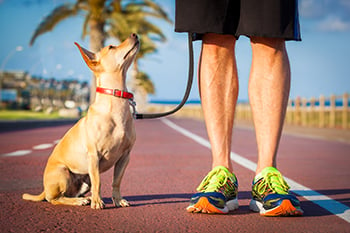
Once you've chosen the behavior you want your dog to do instead of jumping, you've got to put in the work.
Start teaching your dog this behavior when they are calm and not distracted — don't start teaching them to sit when they're already jumping. That's a recipe for frustration.
Start training the behavior using high-value training treats, but remember that dogs tend to jump on people to get attention.
Add in the real-life reward of giving attention through eye contact, petting, and praising your dog when they do the behavior. This will make fading out training treats easier in the long run and teaches your dog that sitting (or fetching, or standing ...) is how they get your attention.
Teaching Polite Greetings
Since jumping on people most often happens when a dog wants to say hi, set up some training sessions to practice polite greetings. Below are two examples of how to do this, one using a gate or tether to practice for when you arrive home and another for teaching your dog how to greet other people while on leash. Adjust these exercises as needed to practice in the context where your dog tends to jump the most.
Teaching Your Dog Not to Jump Up on You Using a Gate or Barrier
What You'll Need:
- Training Treats, like these high value treats from Vital Essentials
Step One: Stand outside of your dog's exercise pen or on the other side of the gate.
Step Two: Calmly approach your dog to say hi.
Step Three: If they keep all four paws on the floor, or offer a sit, toss a treat on the floor near them. You can also pet and praise them over the barrier, as long as they don't start jumping.
If they jump, simply turn and walk away. Watch to see when they stop jumping! Once they stop jumping, toss a treat on the floor for them and praise them.
Training Tip: Why are you tossing the treat on the floor instead of giving it to them from your hand? If your dog learns that treats show up on the floor, they are more likely to look there than to try and jump up to your hand in these scenarios.
You're preventing an instant bounce from your dog by reinforcing them in the position you want them to stay.
Step Four: Repeat this approach/retreat process five to ten times per training session. Try to have multiple training sessions throughout each day.
Step Five: Start to approach with more excitement as your dog progresses. Start to add in exciting talking or clapping your hands as you approach. Same rules though — if they jump, you back away. This is building up the distractions and teaching them that no matter how exciting an approaching person is, they still need to sit to get attention.
By following the steps above, your dog is learning that you will come to say hi to them if they aren't jumping. They're also learning that if they jump up, it makes you go away! This is what we call "negative punishment."
Negative Punishment: Taking something the dog wants away to decrease the frequency of a behavior.
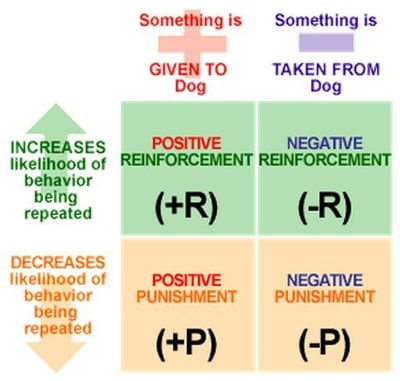
The consequence for jumping up is losing the thing they want — your attention and the opportunity for a treat. When using negative punishment correctly in training dogs, we need to make sure we are using positive reinforcement to reward the behavior we want instead!
Don't just keep walking away without telling your dog what works to get you to come closer.
Positive Reinforcement: Giving the dog something they want to increase the frequency of a behavior.
As you practice this polite greeting exercise, your dog should begin to offer the sit (or whatever behavior you've chosen as the alternative to jumping). It just takes some repetition and consistency on our part for them to learn the association.
When you see your dog starting to offer the behavior instead of jumping, then you can make it a bit harder and practice without the gate.
Other options for this training exercise:
- Tether your dog or have a family member or friend hold the leash. If you don't have a gate to work behind, you can tether your dog's leash to a sturdy piece of furniture (like the leg of a couch or a doorknob), or have someone hold the leash, and practice approaches this way. Watch an example of using a tether for this exercise in this video:
- Give your dog a training cue. I like to practice this exercise without asking my dog for anything — this is teaching your dog to make the right choice instead of waiting for you to tell them what to do. However, you can certainly help your dog if they're having trouble figuring it out by telling them "sit," then rewarding the sit with attention and a treat.
Teaching Your Dog Not to Jump Up When Greeting People
What You'll Need:
- Training Treats
- Your dog on a leash
- A friend or family member to act as a "decoy"
Step One: Start outside with your dog on leash with your helper at a distance.
Step Two: Begin approaching your helper, as long as your dog isn't pulling or jumping to get to them.
Step Three: If your dog doesn't jump, your helper can greet them. The helper can use attention and pet and praise the dog for approaching without jumping, or can even give your dog a treat.
Step Four: If your dog does jump, at any point in the approach, say "oops!" and turn and guide them further away from the helper. When your dog can focus on you, stop and ask for a sit or other simple behavior, such as touch. Then begin approaching your helper again.
Step Five: Keep up the practice! As your dog gets better at offering a sit and calmly approaching someone to say hi, you can make this scenario harder. Have your helper act more excited as you practice, patting their legs or speaking in an excited voice. Any time your dog jumps, they lose the greeting opportunity — but if they sit or keep all four paws on the ground, they get the attention they want!
Other options for this training exercise:
- Switch up who is doing the approaching. Have your dog sit next to you and the helper walking towards them to say hi. If your dog jumps, the helper simply turns and walks away. If they stay seated, the helper can greet them with praise, petting, and a treat.
- Practice off-leash in your home or fenced yard. If you don't have a securely fenced yard, use a long lead to provide a more "off-leash" feel for your dog. This is great to practice greeting people politely when you aren't right next to your dog to manage the situation.
- Teach your helper how to lure your dog into a sit. This can help a dog that has a strong history of jumping by showing them what to do before they have a chance to jump. Watch an example of a guest decoy teaching a dog to sit for greetings in this video:
Capture Good Behavior BEFORE Your Dog Starts Jumping Up
Having your training treats or toys ready to use in different places around the home means that you can capture good behaviors before your dog starts to jump. Here's an example of capturing non-jumping behavior:
- You grab a couple of treats from your stocked treat jar in the garage or on the front patio before you enter your home.
- You walk through the door and see your dog running to greet you.
- Before your dog gets close enough to leap onto you, you toss a treat on the ground.
- They stop to gobble up the treat.
- As they finish chewing, you toss another treat on the ground.
- Repeat a few times, keeping your dog's nose sniffing out yummy treats on the floor while you enter the room. This is preventing jumping while rewarding not jumping on you. You're keeping your dog engaged in appropriate behavior so they can't practice jumping. You can then get down on their level to greet them or go about your business.
Watch this video from Kikopup for a comprehensive overview and different examples of the no-jumping training techniques outlined above:
What to Do When Your Dog Jumps Up on People
For dogs that have a history of jumping, there will inevitably be a time when you aren't fast enough to prevent the jumping from happening. So what should you do (and NOT do) when this happens?
DON'T Yell, Push, or Knee Your Dog
You might have heard the advice to knee or hit your dog when they jump up on you. Not only is this training outdated, it almost never works to curb jumping behavior in the long run. I grew up with Rottweilers, and if they jumped and you tried to knee them, they thought you wanted to play. Not exactly the response we want.
If you have a large dog, pushing or kneeing them when they jump usually entices more play and jumping behavior. They wanted physical contact and your attention, and you just gave it to them! While we might consider pushing them off a negative response or form of punishment, your dog might not see it that way.
Smaller dogs can be seriously injured by physical corrections like kneeing or hitting. Any training methods that can cause your dog injury should be avoided at all costs! Any training tools that cause pain or discomfort should also be avoided, such as electronic collars or prong and choke collars.
No matter the dog's size, when we add something unpleasant to the situation, we are playing with fire. Dogs learn by association, and if we respond to jumping with physical punishment or scary yelling, your dog could be associating you or other people with negative things.
These negative associations can lead to leash reactivity or fear-based aggression — trust me, it's not worth the unintended consequences for short-term results. To learn more, check out our article "Dog Training Aversives: What Are They and Why Should You Avoid Them?"
DO Interrupt and Redirect Your Dog's Jumping Up on Other People
If your puppy is jumping on guests, don't expect your visitors to know what to do. Some people inadvertently reward the jumping! And while they might not mind it, another future guest might be overwhelmed or injured. Interrupt your dog's jumping and guide them to an area where they cannot jump up on people or put them on a leash so you can better control the situation.
You can ask them for a sit and then allow them to greet your visitors, or simply give them something else to do in their crate, pen, or puppy zone.
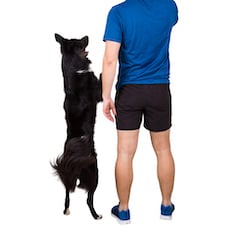 DO Ignore Your Dog's Jumping Up on You or Move Away
DO Ignore Your Dog's Jumping Up on You or Move Away
What should you do when your dog jumps on you? Remove all attention, turn away, or completely walk away.
Depending on the intensity of the jumping, I might only need to step to the side when they jump. This gives the chance for them to either offer a good behavior or for me to ask for a behavior, such as sit.
If I'm working with an uber-excited puppy, I might completely turn my back or walk right back out the door I just entered. This is practicing negative punishment. If you jump on me, I go away!
Ignoring your dog's jumping will only work when everyone is consistent.
If one family member rewards jumping with attention (even if it's negative attention), it will take a long time for a dog to learn not to jump on people (if ever). Sit down with everyone in your home to make sure you're on the same page when it comes to how to respond to jumping.
If your dog is jumping on guests or on people while out for a walk, it's up to you to stop them. Do this by getting their attention and guiding them away. A treat in front of your dog's nose can work wonders to help them focus and then lure them away.
For when people are entering your home, you can either put them in their safe space while your guest gets settled or practice polite greetings by having them on a leash or behind a gate and asking your dog for a sit before they get a treat and any attention.
You can certainly ask people if they are willing to help train and let them know what to do if your dog starts to jump. However, this is where I see the most accidental reinforcement of jumping. Many kind strangers who want to say hi to your dog will say, "Oh, I don't mind!" But if they allow jumping, any training progress you've made up to that point has been erased.
Ignoring your dog's jumping will only work if you teach them what to do instead.
Don't forget — ignoring jumping is only half of the equation! Your puppy or adult dog needs to be taught an incompatible and alternative behavior to get what they want. Without this, many dogs will keep jumping because it's worked for them in the past.
And ignoring a jumping dog for longer than a few seconds is really tough to do. Eventually we humans give in, and then our dogs have just learned they need to jump on you longer or harder.
DO Re-Assess Your Training Plan
If you're not seeing a decrease in jumping after practicing the training exercises outlined earlier in this article, it's time to evaluate what could be going wrong.
Every dog is unique and learns at different rates — if your dog has been jumping since they were a puppy, you're up against quite a reinforcement history!
Here are two common things that might be happening if your dog is having trouble not jumping on people:
- Is the jumping behavior being inadvertently rewarded? This could be one family member, friend, or even a stranger on the street that allows the jumping, or responds by giving your dog attention.
- Are you rewarding alternative and incompatible behaviors? If you're only practicing the consequence for jumping (removing attention), but not rewarding a sit or other replacement behavior, your dog won't know what to do — might as well keep jumping or jump more!
Teaching your dog not to jump takes management, time, and patience — don't give up!
Why Do Dogs Jump on People?
Dogs Jump on People for Attention
One of the top reasons dogs jump up on you is to get your attention. And guess what? It usually works! Dogs will do what works for them and if jumping has gotten you to look at them, touch them, push them down, or whatever kind of attention it might be (positive or negative!), they'll try it again.
Our human hands and faces are the main sources of attention for dogs, and unfortunately, these things are high up — meaning your dog needs to jump to get to them.
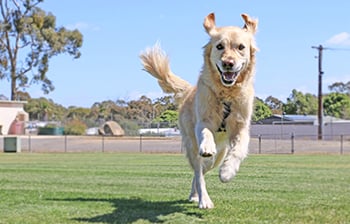
Dogs Jump on People Out of Excitement
I've seen many dogs bouncing around simply because they're excited. They might be arriving to or being picked up from dog daycare, over the moon about an arriving guest, or they see their best dog buddy down the street while out on a walk.
All of that excitement leads to a higher level of arousal in a dog, and this is often exhibited with jumping.
Other Reasons for Jumping
Your Dog Might be Scared or Anxious
If a puppy or dog is startled or anxious about something in their environment, sometimes they might jump on or try to climb up their owner in an effort to feel more safe and secure. This kind of climbing or jumping is seen with fearful or anxious canine body language, such as tail tucked, ears pinned against the head, and wide eyes.
Your Dog Might be Trying to Alert You to Something
This is closely related to jumping up to get attention from you, but a dog might jump to alert you to something in the environment. This could be someone or something approaching, or an alert to a biological change they sense happening in you.
Some medical alert dogs and service dogs jump on their owner when they sense a drop in blood sugar or a chemical change that predicts a seizure or other medical or behavioral issue. Jumping on someone tends to be the most obvious way for a dog to get their attention if nosing or pawing at them doesn't work.
Your Puppy Might be Overstimulated
Puppies might be jumping up on you because they're overstimulated. All that energy has to go somewhere, might as well be up! Puppies tend to get overstimulated when they are hungry, tired, or there's a lot happening in their environment and they aren't sure what to do.
Jumping due to overstimulation is often combined with nipping, barking, or the "zoomies."
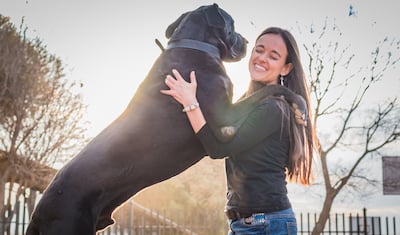 Have You Taught Your Dog to Jump Up?
Have You Taught Your Dog to Jump Up?
In some cases, dogs have been taught to jump up for greetings. And while you might not mind your dog jumping on you to say hello, it's hard for your dog to know that they shouldn't jump up on other people in the same context.
If you train your dog to jump up, make sure they are only doing so when asked and not just jumping on people without an invitation.
Get Help from a Certified Professional Dog Trainer for Your Dog's Jumping
Dealing with frustrating puppy jumping or an adult dog who has a bad habit of jumping on people can be exhausting for many dog owners. You don't have to (and shouldn't!) go it alone.
Often having another set of eyes helps identify jumping "pain points" and unconscious habits that may be accidentally rewarding jumping. Training your dog to stop jumping on people will be easier and faster with professional help.
If you're struggling with dog jumping, sign up for our Dog Training Essentials: Jumping & Counter Surfing Workshop.
You'll get unlimited access to the self-paced curriculum, step-by-step instructions, video demonstrations, and more — all for just $9!



